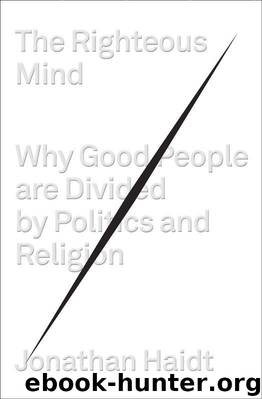The Righteous Mind: Why Good People Are Divided by Politics and Religion

Author:Jonathan Haidt [Haidt, Jonathan]
Language: eng
Format: epub
Tags: Political Ideologies, Psychology, Philosophy, Psychology of Religion, Religion, Conservatism & Liberalism, Political Science, Social Psychology, Ethics & Moral Philosophy
ISBN: 9780307377906
Google: ItuzJhbcpMIC
Amazon: 0307377903
Publisher: Pantheon
Published: 2012-03-13T04:00:00+00:00
In the 1980s the geneticist William Muir used group selection to get around this problem.80 He worked with cages containing twelve hens each, and he simply picked the cages that produced the most eggs in each generation. Then he bred all of the hens in those cages to produce the next generation. Within just three generations, aggression levels plummeted. By the sixth generation, the death rate fell from the horrific baseline of 67 percent to a mere 8 percent. Total eggs produced per hen jumped from 91 to 237, mostly because the hens started living longer, but also because they laid more eggs per day. The group-selected hens were more productive than were those subjected to individual-level selection. They also actually looked like the pictures of chickens you see in children’s books—plump and well-feathered, in contrast to the battered, beaten-up, and partially defeathered hens that resulted from individual-level selection.
Humans were probably never subjected to such a strong and consistent selection pressure as were those foxes and hens, so it would take more than six or ten generations to produce novel traits. But how much longer? Can the human genome respond to new selection pressures in, say, thirty generations (six hundred years)? Or would it take more than five hundred generations (ten thousand years) for a new selection pressure to produce any genetic adaptation?
The actual speed of genetic evolution is a question that can be answered with data, and thanks to the Human Genome Project, we now have that data. Several teams have sequenced the genomes of thousands of people from every continent. Genes mutate and drift through populations, but it is possible to distinguish such random drift from cases in which genes are being “pulled” by natural selection.81 The results are astonishing, and they are exactly the opposite of Gould’s claim: genetic evolution greatly accelerated during the last 50,000 years. The rate at which genes changed in response to selection pressures began rising around 40,000 years ago, and the curve got steeper and steeper after 20,000 years ago. Genetic change reached a crescendo during the Holocene era, in Africa as well as in Eurasia.
It makes perfect sense. In the last ten years, geneticists have discovered just how active genes are. Genes are constantly turning on and off in response to conditions such as stress, starvation, or sickness. Now imagine these dynamic genes building vehicles (people) who are hell-bent on exposing themselves to new climates, predators, parasites, food options, social structures, and forms of warfare. Imagine population densities skyrocketing during the Holocene, so that there are more people putting more genetic mutations into play. If genes and cultural adaptations coevolve in a “swirling waltz” (as Richerson and Boyd put it), and if the cultural partner suddenly starts dancing the jitterbug, the genes are going to pick up the pace too.82 This is why genetic evolution kicked into overdrive in the Holocene era, pulling along mutations such as the lactose tolerance gene, or a gene that changed the blood of Tibetans so that they could live at high altitudes.
Download
This site does not store any files on its server. We only index and link to content provided by other sites. Please contact the content providers to delete copyright contents if any and email us, we'll remove relevant links or contents immediately.
| Anarchism | Communism & Socialism |
| Conservatism & Liberalism | Democracy |
| Fascism | Libertarianism |
| Nationalism | Radicalism |
| Utopian |
The Secret History by Donna Tartt(18844)
The Social Justice Warrior Handbook by Lisa De Pasquale(12141)
Thirteen Reasons Why by Jay Asher(8793)
This Is How You Lose Her by Junot Diaz(6794)
Weapons of Math Destruction by Cathy O'Neil(6142)
Zero to One by Peter Thiel(5685)
Beartown by Fredrik Backman(5596)
The Myth of the Strong Leader by Archie Brown(5425)
The Fire Next Time by James Baldwin(5248)
How Democracies Die by Steven Levitsky & Daniel Ziblatt(5127)
Promise Me, Dad by Joe Biden(5087)
Stone's Rules by Roger Stone(5026)
A Higher Loyalty: Truth, Lies, and Leadership by James Comey(4843)
100 Deadly Skills by Clint Emerson(4840)
Rise and Kill First by Ronen Bergman(4702)
Secrecy World by Jake Bernstein(4644)
The David Icke Guide to the Global Conspiracy (and how to end it) by David Icke(4625)
The Farm by Tom Rob Smith(4435)
The Doomsday Machine by Daniel Ellsberg(4416)
